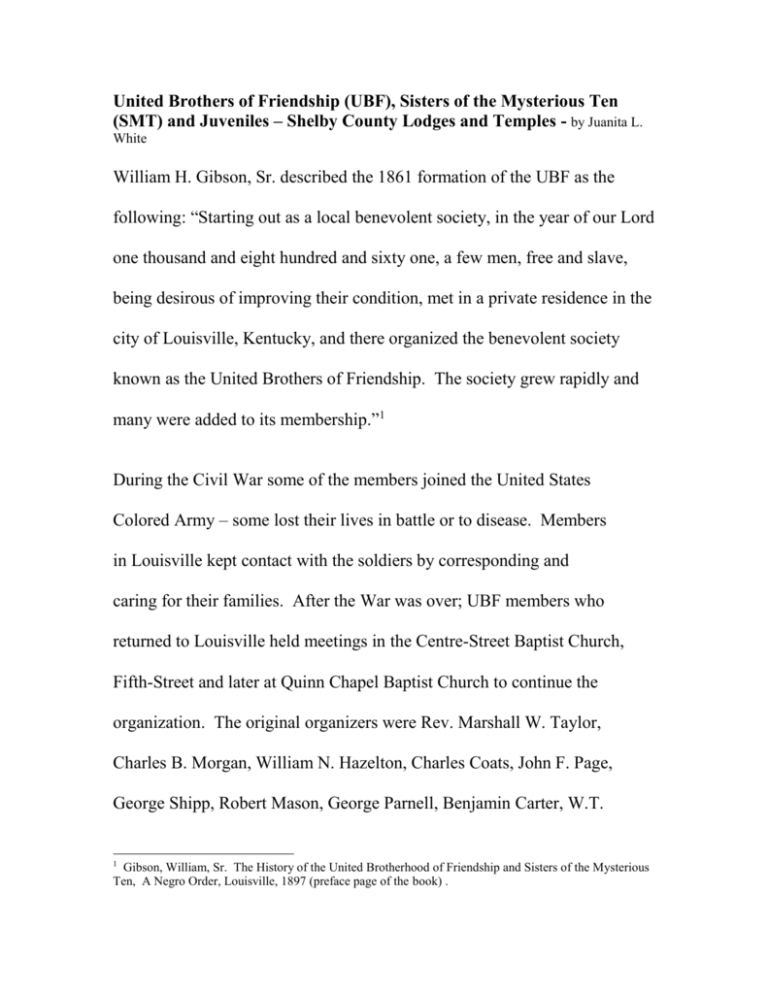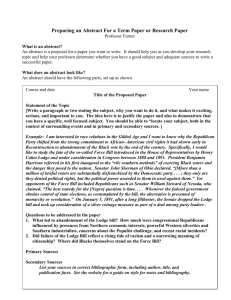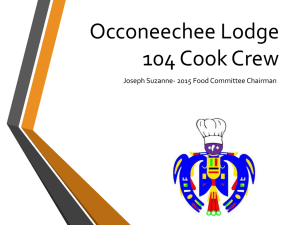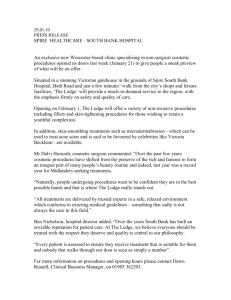full newsletter article - Shelby County Historical Society
advertisement

United Brothers of Friendship (UBF), Sisters of the Mysterious Ten (SMT) and Juveniles – Shelby County Lodges and Temples - by Juanita L. White William H. Gibson, Sr. described the 1861 formation of the UBF as the following: “Starting out as a local benevolent society, in the year of our Lord one thousand and eight hundred and sixty one, a few men, free and slave, being desirous of improving their condition, met in a private residence in the city of Louisville, Kentucky, and there organized the benevolent society known as the United Brothers of Friendship. The society grew rapidly and many were added to its membership.”1 During the Civil War some of the members joined the United States Colored Army – some lost their lives in battle or to disease. Members in Louisville kept contact with the soldiers by corresponding and caring for their families. After the War was over; UBF members who returned to Louisville held meetings in the Centre-Street Baptist Church, Fifth-Street and later at Quinn Chapel Baptist Church to continue the organization. The original organizers were Rev. Marshall W. Taylor, Charles B. Morgan, William N. Hazelton, Charles Coats, John F. Page, George Shipp, Robert Mason, George Parnell, Benjamin Carter, W.T. 1 Gibson, William, Sr. The History of the United Brotherhood of Friendship and Sisters of the Mysterious Ten, A Negro Order, Louisville, 1897 (preface page of the book) . 2. Lewis, David Yancey, Wallace Jones, William Anderson, and William H. Lawson. William W. Jones and others. Two former U.S. Colored Civil War soldiers – Elijah Preston Marrs, Henry C. Marrs and H. Graves of Shelbyville were reported by Marrs in his book as having “organized the second Lodge of the United Brothers of Friendship in the United States, in 1866, in Shelbyville, Ky."2 Julia Gray Marrs (1851-1876), Elijah’s first wife was a member of the SMT and held the position of Most Worthy Mistress (Princess) before her death. Henry Smock (1834-1895), Charles Purdy (1838-1914) and his wife Rebecca (1844-1869), Lloyd Bland (1854- 1919) were early members of the UBF and SMT in the Shelbyville area.3 From the limited UBF/SMT records available the first UBF Lodge organized in Kentucky was the Friendship #1 Lodge of Louisville, thereafter Trim #2 Lodge of Simpsonville, followed by Charity Lodge #3 of Frankfort and then the Excelsior #4 of Shelbyville. By 1888 the annual report of Kentucky 2 Marrs, Elijah P. Life and History of the Rev. Elijah P. Marrs, Louisville, 1885. (pg 139) Marrs, E.P.’s book and Inscriptions with UBF and SMT lettering, UBF lodge triangle and JMT (Justice, Mercy and Truth) lettering on the headstones of Smock, Purdy and Bland in the Shelbyville Saffell Calvary Cemetery and Smock headstone in the African Cemetery of Shelbyville, KY. 3 indicated that there were one twenty- nine lodges throughout the state. The first UBF State Grand Lodge charter was granted through incorporation, by the state of Kentucky, February 7, 1868. This was the “first charted regularly constituted Negro society south of the Ohio River.” 4 The UBF was an original order – not copied from any other white or black order - an original creation. The Morning Star #98 of Todd’s Point was also a Shelby County UBF Lodge. Yoder #74 and Spencer #16 both of Elk Creek were near Shelby County. The Trim, Excelsior and Morning Star lodges were in operation for for many years. The names of the following men from Simpsonville, Shelbyville and Todd’s Point were listed as office holders and committee members – during various periods- with UBF Lodges in 1871, 1888, 1890, 1895, and 1914. These included; H. J. Graves, Henry Jones, T. S. Baxter, J. B. Foster, W. Wilson, Jr., L. G. Baxter, Richard Courtney, Porter Tilly, W.H. Russell, Henry Marrs, Lewis Lawson, George W. Saffell, Jr. Jordan Taylor and W.B. Smith, B. Tyler, William Todd and E. G. Riggs. 5 4 Work, Monroe N. Negro Year Book and Annual Encyclopedia of the Negro 1921-1922. Tuskegee, l922. Information from Gibson’s book and Proceedings of the Seventeenth Annual Session of the UBF and SMT Grand Lodge of Kentucky, Paris, KY August 21,22,23,and 24, 1888. Proceedings of the Nineteenth Annual Session of the UBF and SMT Grand lodge of Kentucky, Owensboro, KY, August 12,13,14, and 15, 1890. Proceedings of the Thirty-Fourth Annual Session of the United Brothers of Friendship, Sisters of the Mysterious Ten, Covington, KY, August 13, 14, 15, and 16, 1895. State Grand Lodge of Kentucky of the United Brothers of Friendship and Sisters of Mysterious Ten, Juveniles of the State of Kentucky – Third Quarterly Circular and Reports of the Grand Secretary and Grand Treasurer, Louisville, KY, April 18, 1914. 5 There was a UBF lodge hall was on the corner of 5th at Bradshaw in Shelbyville for several years. Lodge and temple meetings were held there. It was reported that the building burned down during the 1960s. UBF OBJECTIVES The goals of the organization included spreading Christianity, caring for widows and orphans (there was an Orphans’ Home – Brooks Station Kentucky), assisting impoverished members with decent burials, purchasing property for lodge halls and burial grounds, caring for sick members, and encouraging youth to acquire an education/or trade. The organization provided “relief” insurance for its members to cover sickness or death. Young males were provided military training for the “common defense” of the country. Political activism by the membership became a driving force of the organization to improve the plight of African Americans against the ravages of segregation, discrimination, racism and poverty. In all of its years of operation the UBF and its subordinate lodges/temples never strayed away from its goals.6 6 Wright, George C. Life Behind a Veil Blacks in Louisville, Kentucky, 1865-1930, Baton Rouge, Louisiana State Press (pg 133). Males between the ages of 18-55 could join after meeting application and screening requirements. By 1922 the UBF and SMT state and national membership had reached 100,000 with members throughout the United States. There was a lodge in the Virgin Islands and one in Liberia, West Africa. State Grand Lodge meetings were held during the month of August at sites all over the Kentucky easily accessible along rail road lines. National lodge meetings were held throughout the United States as well. Yearly minutes from lodge/temple (SMT) meetings – sometime consisting of eighty to ninety pages – were distributed to the membership. Minutes had columns of information accounting for lodge and temple locations, number of members, value of property, taxes paid, names of the Master (UBF president), Princess (SMT president) and secretaries as well as a number of other items sent in by each of the organizations. Lodges and Temples were fined for not reporting information on time for annual publications. SISTERS OF THE MYSTERIOUS TEN Initially the UBF organization was composed of male members only, until 1876 when a female branch of the order, known as the Sisters of the Mysterious Ten was added during the national UBF meeting in St. Louis. Women had been working alongside men of the UBF for years but were not officially attached as a group to the UBF. The wives, sisters, daughters, mothers and any other well “disposed women” who sought to accomplish the same goals as outlined by the men could join the SMT. Women between the ages of 16-50 could make application to join. The bylaws required that four UFB men had to be present during SMT Temple meetings. Esther #5 (Shelbyville), Union #11 (Shelbyville) and Marcellus #105 (Simpsonville) were Shelby County Temples for a number of years. Rebecca Dupee, Florence Hall, Alice L. Logan, Mary E. Fletcher, and Emma E. Chinn were listed in 1888, 1890, 1895 and 1914 SMT state grand lodge and national meeting minutes. 7 The Esther #5 Temple of Shelbyville was included in the 1944-59 National Grand Temple minutes.8 JUVENILE DEPARTMENT In July of 1882 a juvenile department, for youth, was organized as part of the Grand Lodge of UBF and SMT. The Juvenile Lodges (J.U.B.F) were for Proceedings of the 1888, 1890, 1895 and 1914 national annual sessions – see footnote number 6. 1944-1959 Ledger, National Grand Temple Sisters of the Mysterious Ten, Auxiliary to the United Brothers of Friendship of North America and Africa – the record book of Mrs. Rosa L. Green, National Assistant Secretary – Owensboro, KY. 7 8 boys aged 5-18 and the Juvenile Temples (J.S.M.T.) included girls aged 5Education, moral training, cultural traditions and land ownership were emphasized. Golden Link #36 (Shelbyville) and Gaines #77 (Simpsonville) were the Juvenile organizations Shelby County. WHO JOINED? Across Shelby County and Kentucky lodge and temple membership included cooks, farm hands, maids, painters, undertakers, ministers, teachers, doctors, lawyers, washerwomen, brick masons, janitors, porters, blacksmiths – people of all economic and social levels. Men (and members of their sister organizations) who were members of the Masons, Knights of the Pythias, GUOOF and other fraternal and benevolent groups were also members of UBF and SMT. Former veterans of the United States Colored Army held Offices and were members of the UBF. The children of lodge and temple members were a part of the juvenile lodge and temple groups as well. CEMETERIES To assure that loved ones were properly cared at the time of death UBF/SMT members purchased property for cemeteries or lots within cemeteries for the burial of family and members. The Trim #2 UBF lodge acquired property on US 60 near Simpsonville for a cemetery (Chord Williams and Fulton Calbert (and his son L. Edward Calbert) were the last officers and caretakers in 1950s ’early 1960s). The African Cemetery Cemetery and Saffell Calvary cemeteries in Shelbyville have headstones of deceased lodge/temple members which are engraved with the emblems of the organizations. A triangle with a five pointed star inside with the lettering UBF or JMT – justice, mercy and truth represented UBF membership. A circle with a dove inside represented SMT membership. The Saffell Calvary Cemetery has a number of graves so marked. These include George W. Saffell, Lloyd Bland, Charles and Rebecca Purdy. The headstone of Henry Smock - African Cemetery - has a triangle on it with the lettering of UBF. These same cemeteries are the final resting place of former Civil War veterans and their family members connected to the UBF lodges or SMT temples in Shelby County. African Cemetery burials - Shelbyville . Alexander Riggs (alias Alex Harbison - CO A 109th USCI) brother E. G. (Eli Grant) Riggs belonged to the Shelbyville UBF. . Julia Gray Marrs 1st wife of Rev. Elijah P. Marrs (CO L12th USCHA and also an UBF member) was a Shelbyville SMT member. . Ennis Redding (CO K 123rd USCI alias Dennis Redmon) is buried here. Trim #2 UBF Cemetery . Joseph Henry Todd (CO A 109th USCI) and his 1st wife Minerva are buried at this site (second wife Julia is at Saffell Calvary). . a number of the family members of Charles Busey (CO A 13th USCHA) are buried in a family plot. . Fannie Hughes Evans wife of James Evans alias James Hall CO K 109th USCI is buried at this site. Montclair Cemetery This pocket African American Shelby County community has a cemetery which includes Wilkerson Bullitt (CO E 13th USCHA) and William Fields (CO A 123rd USCI). Wilkerson Bullitt’s has family members buried in the Trim UBF Cemetery. Saffell Calvary Cemetery . Charles Purdy (CO B 13th USCHA) and his wife Rebecca were UBF and SMT members. . Rebecca Smock Tilley was a SMT office holder – her husband was Joseph E. Tilley of CO I 5th USCC and her father Henry Smock was a UBF member. . Rebecca Dupee was a SMT office holder – her husband Henry Dupee was in CO E 116th USCI – he is buried at this site as well. . William Todd UBF office holder is buried here. 10. DEMISE OF THE UBF AND SMT During the late 1940s through the 1960s UBF and SMT organizations across the state and nation either had disbanded or were in the state of decline. Lodge halls and properties were sold and some of the cemeteries were not properly maintained. The exact cause (or causes) is not clear. It could have been the organization’s inability to attract younger members. Internal problems may have been a factor. Wars and economic depressions may have caused decline. The migration of Kentucky African Americans to points west or north because of KKK terrorism may have depleted populations in a number of Kentucky areas where the lodges/temples had membership. It could have been men and women leaving Simpsonville and Shelbyville to go to larger cities to seek jobs. Whatever the cause or causes for the organization to no longer exist - it is for certain that the UBF/ SMT provided valuable services and resources to Shelby County African Americans and other communities at large across Kentucky and nation for over one hundred years. SHELBY BROTHERHOOD LODGE (SBL) The Shelby Brotherhood Lodge was formed just after the UBF and SMT organizations ceased to operate. Former Shelbyville UBF and Knights of the Pythias lodge members became SBL members. Meetings were held in the old UBF hall at 5th Bradshaw Street in Shelbyville. When the old wooden frame UBF lodge hall burned down around 1962 (including all of its records and lodge artifacts) the SBL built a new two-story concrete block lodge hall on the same site. The goals of the SBL were basically the same as the UBF. Members assisted the sick and provided financial aid for families of deceased members. Ceremonies were held at the burial site, which included reading of scriptures, prayer and songs. Monies to assist members were raised through monthly dues and social events. At one time the membership included one hundred men. About the year of 1980 the lodge hall was sold to Samuel Caldwell to operate a restaurant. 9 Former member included: George W. Saffell, Cecil White, Richard Purdy, Sterling Churchill, Ernest Bullitt, Eddie Skinner, Calvin Wilson, Mose Ellis, Guy R. Coleman, Columbus Sykes, Henry Simpson, Isaac Stivers, George Davis, Claywood Stivers, Stanley Davis, Everett Stivers, Eddie Lee Davis, Pete Davis, James Wooten, Rubin Maddox, Everett Stivers, Jr., James Beasley, William Stivers, George Morton and Jake Stivers who was the last SBL president. 9 Information about the Shelby Brotherhood Lodge came from Jake Stivers (now deceased) and George Morton of Shelbyville and Everett Stivers of Louisville in 3/2001– all were former members of the SBL. Juanita l. White, a former educator, is a member of the Shelby County Historical Society. Information about the UBF/SMT was part of the script she wrote for the characterization of “ Miss Dinnie Thompson” a KY Humanities Council Chautauqua character. Dinnie was a Louisville SMT member . Research by LaVerne D. Dunning, genealogist, on Shelby County Civil War soldiers, cemetery sites and African American families is reflected in this report. So much more could be said about the UBF/SMT regalia, newspaper, Decoration Day (Memorial Day) and annual Thanksgiving Day programs, funeral ceremonies, drill competitions, and Simpsonville/Shelbyville church involvement and accomplishments made by individual members. More could be said about persons in Simpsonville/Shelbyville who have UBF /SMT artifacts in attics, closets, and garages that need to be found before younger family members, friends or care takers toss them out or they become delicious meals for rodents. So much more could be said … but that’s enough for right now.









